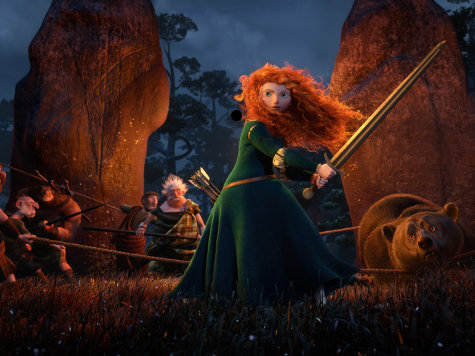
The new Disney-Pixar collaboration “Brave,” an animated Scottish fairy tale, is a smash hit, earning around $70 million in its first weekend and leaving its competition in the bog. As expected from the Pixar folks, it’s technically amazing and visually stunning.
But what is also amazing is the way “Brave” adopts a deeply politically incorrect outlook that, if they think about it, will blow the minds of the kind of liberal parents who insist their sissy kids eschew playing with toy guns in favor of “feelings dolls” and non-gender-normative role playing games.
“Brave” is a movie that appeals to traditional, Middle America on many levels, and it rejects the kind of elitist conformity that brought us a hipster generation whose members find cause for pride in their synchronized tribal tattoos, matching skinny jeans, and shared pose of ironic detachment. There’s no irony in “Brave;” it’s all right there, with its heart on its sleeve. It’s a glorious act of rebellion against the Hollywood status quo worthy of the untamable Scots it chronicles.
“Brave” rebels by truly embracing family. Of course, that’s nothing special in itself; most “family” films purport to. But what most “family” films actually embrace is a weird mutation of “family” as most Americans know it. No, that’s not in the sense that the central characters are a traditional nuclear family with a dad, mom and kids. It’s in the sense that “Brave” bravely embraces, and celebrates, each one’s roles and treats each one with respect instead of putting forward the same hackneyed clichés that were old back in 1973 when Bob Crane put his pants back on long enough to mug his way through “Superdad.”
The mother is kind but imperfect, clashing with the heroine Princess Merida, a headstrong teen. The mother is not a shrew or a harpy; she has wisdom — real wisdom that she tries to instill in her daughter. And the daughter – I will avoid spoilers to all you to enjoy the story as it unfolds – actually learns some lessons.
Imagine that – a Hollywood movie where the teenager isn’t the font of all insight!
And it gets even more shocking. The father – gasp – is not a clown!
Merida’s father Fergus, the king, is a Scot warrior. He’s jolly, sometimes silly, but a true kincaid – a battle chief. Very close to the beginning, there is a scene that truly sets the tone. An enormous bear threatens young Merida. Fergus throws his child out of the line of fire, draws his broadsword, challenges the bear and charges in. The aftermath is not shown, but Fergus pays a terrible price yet never complains.
No goofy sitcom dad here. Kids have a right to expect their father to be capable and prepared to fight and if need be die to protect them (as later Merida mother proves herself), but why would they when Hollywood typically depicts dads as either man-children or self-absorbed losers?
Merida herself is an exceptional princess in several ways, and “Brave” handles her wonderfully. She is rebellious and headstrong, but she also learns responsibility. As a princess, tradition holds that she must be wed to the son of one of the other clan lords. She resists – that’s the crux of the plot – but in the resolution she realizes that more than just her own “dreams” are at stake. Without the marriage, the clans will devolve into warfare, causing untold misery.
I won’t spoil the resolution, but the movie is quite clear that your personal happiness is not the only consideration – nor necessarily the most important. Also very welcome is a sequence where Merida praises her suitors and their fathers for their bravery in war defending Scotland from invaders.
First, the movie showed a father acting like a man, and then it treated fighting your nations’ enemy as something positive. Is this really a Hollywood movie? That makes “Brave” a million times more subversive than the usually “edgy” lefty Tinseltown attempt to blow the collective mind of its bourgeois audience.
But the implicit message of supporting your nation’s troops is no surprise from a Disney production; at a recent Operation Gratitude assembly packing care packages for soldiers in Van Nuys, California, dozens of Disney volunteers in Disney shirts arrived to give up their Saturday to help out.
And there’s one more interesting – and very non-PC – aspect to “Brave.” Weapons abound and are part of the characters’ daily lives, right up to the Queen’s repeated, exasperated command of “No weapons on the table!” Merida herself is an expert archer. As someone who grew up – like many millions of others whose family came from rural America – with shotguns and rifles in racks around the house, it’s satisfying to see the experience a huge number of Americans outside of the coastal cities shared on film.
Turn that bow into a .22 and Merida is no different than millions of American girls today – many of whom will someday serve their country in uniform.
And when this movie talks about bravery, it’s not some New Agey lameness about “being brave enough to be yourself” or some similarly mush-mouthed crap. It’s about being brave in battle. That’s refreshing.
I would expect, if asked, the makers to deny any conscious intent to undermine the usual clichés and tropes we’ve seen flowing out of Hollywood. But intentional or not, “Brave” provides an antidote to the stale, sometime destructive junk that so often gets put forward as “family fare.” And the whole family can enjoy it; I did, and my Scot/Cuban/German-American daughter especially loved it.
Maybe we’re getting through to Hollywood.

COMMENTS
Please let us know if you're having issues with commenting.